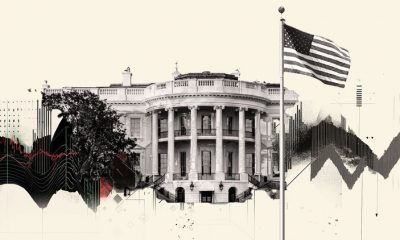

others
Gold slumps to two-week low as fears of wider Iran-Israel conflict wane – Crypto News
- Gold price slips below $2,300 as fears of widening Middle East conflict wane.
- The US Dollar’s appeal improves on a strong US economic outlook.
- The Fed supports keeping interest rates higher until there is confidence that inflation will return to 2%.
Gold price (XAU/USD) extends its downside for a second consecutive day, trading slightly below the crucial support of $2,300 in Tuesday’s European session. The precious metal shifts into bearish territory as investors shrug off Middle East fears amid hopes that the conflict between Iran and Israel will not escalate further. This has improved investors’ risk appetite while safe-haven demand has waned.
The outlook of Gold turns vulnerable as an improved appeal for the US Dollar negatively impacts the dollar-denominated commodity. Investment banking firm Goldman Sachs said: “As we move into the second quarter, ongoing upgrades to already-robust US growth forecasts give the FOMC the luxury of a later and more gradual policy adjustment.” The US Dollar Index (DXY), which tracks the US Dollar’s value against six major currencies, hovers near 106.00.
Meanwhile, 10-year US Treasury yields trade sideways around 4.62% as the focus shifts to the US core Personal Consumption Expenditure Price Index (PCE) data for March, which will be published on Friday. The inflation data will provide cues about the Federal Reserve’s (Fed) guidance on interest rates in the May policy meeting, in which policymakers are widely anticipated to keep them unchanged in the range of 5.25%-5.50%. The Fed’s preference for keeping interest rates higher bodes well for the US bond yields and weighs on Gold.
Daily digest market movers: Gold price tumbles while US bond yields turn sideways
- Gold price dips below the crucial support of $2,300 as safe-haven demand has melted amid easing Middle East tensions. The limited retaliatory attack from Israel on Isfahan against the hundreds of missiles and drones launched in their state on April 13 as well as Iran’s no plan for an immediate response indicate that both nations aren’t interested in widening the conflict.
- Apart from that, recent hawkish guidance from Federal Reserve policymakers on interest rates has also weighed on Gold. Fed policymakers see the current monetary policy framework as appropriate given that inflation has remained stubbornly higher in the first three months of this year and labor demand remains robust.
- Fed policymakers are expected to keep interest rates at their current levels until they get confidence that inflation will come down to the 2% target. Currently, traders expect that the Fed will start reducing interest rates from the September meeting. This week, investors will focus on the US core PCE Price Index data, which will influence expectations for Fed rate cuts.
- The monthly core PCE is estimated to have grown steadily by 0.3%, with annual figures decelerating to 2.6% from 2.8% in February. The core PCE is the Fed’s preferred inflation measure as it excludes volatile food and energy prices. Softer-than-expected US inflation numbers would increase expectations of early rate cuts by the Fed, which will help Gold gauge a firm footing. On the contrary, sticky or hotter-than-expected figures will likely weigh on Gold prices.
- Before the US core PCE inflation data, investors will focus on the preliminary Q1 Gross Domestic Product (GDP), which exhibits the performance of the US economy in the period. The economy is anticipated to have expanded at an annualised pace of 2.5%, slower than the 3.4% increase noted in the last quarter of 2023.
Technical Analysis: Gold price tests region below $2,300
Gold price faces an intense sell-off after a breakdown of the Symmetrical Triangle formation on the hourly time frame. The precious metal slips below $2,300 as a downside break of the above-mentioned pattern explodes the volatility, resulting in wider ticks on the downside and heavy selling volume.
The 20-period Exponential Moving Average (EMA) at $2,317 is acting as a major barricade for the Gold price bulls. The 14-period Relative Strength Index (RSI) has delivered a range shift move from the 40.00-60.00 territory to the 20.00-40.00 region, indicating that a bearish momentum has been triggered.
Fed FAQs
Monetary policy in the US is shaped by the Federal Reserve (Fed). The Fed has two mandates: to achieve price stability and foster full employment. Its primary tool to achieve these goals is by adjusting interest rates. When prices are rising too quickly and inflation is above the Fed’s 2% target, it raises interest rates, increasing borrowing costs throughout the economy. This results in a stronger US Dollar (USD) as it makes the US a more attractive place for international investors to park their money. When inflation falls below 2% or the Unemployment Rate is too high, the Fed may lower interest rates to encourage borrowing, which weighs on the Greenback.
The Federal Reserve (Fed) holds eight policy meetings a year, where the Federal Open Market Committee (FOMC) assesses economic conditions and makes monetary policy decisions. The FOMC is attended by twelve Fed officials – the seven members of the Board of Governors, the president of the Federal Reserve Bank of New York, and four of the remaining eleven regional Reserve Bank presidents, who serve one-year terms on a rotating basis.
In extreme situations, the Federal Reserve may resort to a policy named Quantitative Easing (QE). QE is the process by which the Fed substantially increases the flow of credit in a stuck financial system. It is a non-standard policy measure used during crises or when inflation is extremely low. It was the Fed’s weapon of choice during the Great Financial Crisis in 2008. It involves the Fed printing more Dollars and using them to buy high grade bonds from financial institutions. QE usually weakens the US Dollar.
Quantitative tightening (QT) is the reverse process of QE, whereby the Federal Reserve stops buying bonds from financial institutions and does not reinvest the principal from the bonds it holds maturing, to purchase new bonds. It is usually positive for the value of the US Dollar.
-

 Technology4 days ago
Technology4 days agoChatGPT users are mass cancelling OpenAI subscriptions after GPT-5 launch: Here’s why – Crypto News
-
Technology1 week ago
Binance to List Fireverse (FIR)- What You Need to Know Before August 6 – Crypto News
-

 Technology1 week ago
Technology1 week agoBest computer set under ₹20000 for daily work and study needs: Top 6 affordable picks students and beginners – Crypto News
-
Technology1 week ago
Beyond Billboards: Why Crypto’s Future Depends on Smarter Sports Sponsorships – Crypto News
-
Cryptocurrency1 week ago
Cardano’s NIGHT Airdrop to Hit 2.2M XRP Wallets — Find Out How Much You Can Get – Crypto News
-

 others1 week ago
others1 week agoBank of America CEO Denies Alleged Debanking Trend, Says Regulators Need To Provide More Clarity To Avoid ‘Second-Guessing’ – Crypto News
-
others1 week ago
Japan CFTC JPY NC Net Positions down to ¥89.2K from previous ¥106.6K – Crypto News
-

 Technology1 week ago
Technology1 week agoGoogle DeepMind CEO Demis Hassabis explains why AI could replace doctors but not nurses – Crypto News
-
Business1 week ago
Analyst Spots Death Cross on XRP Price as Exchange Inflows Surge – Is A Crash Ahead ? – Crypto News
-
others1 week ago
Pi Network Invests In OpenMiind’s $20M Vision for Humanoid Robots- Is It A Right Move? – Crypto News
-
Business1 week ago
Pi Network Invests In OpenMiind’s $20M Vision for Humanoid Robots- Is It A Right Move? – Crypto News
-

 De-fi1 week ago
De-fi1 week agoTON Sinks 7.6% Despite Verb’s $558M Bid to Build First Public Toncoin Treasury Firm – Crypto News
-
Cryptocurrency4 days ago
DWP Management Secures $200M in XRP Post SEC-Win – Crypto News
-

 De-fi1 week ago
De-fi1 week agoCircle Extends Native USDC to Sei and Hyperliquid in Cross-Chain Push – Crypto News
-

 Blockchain1 week ago
Blockchain1 week agoXRP Must Hold $2.65 Support Or Risk Major Breakdown – Analyst – Crypto News
-

 Blockchain1 week ago
Blockchain1 week agoXRP Must Hold $2.65 Support Or Risk Major Breakdown – Analyst – Crypto News
-
Business1 week ago
Is Quantum Computing A Threat for Bitcoin- Elon Musk Asks Grok – Crypto News
-

 Technology1 week ago
Technology1 week agoElon Musk reveals why AI won’t replace consultants anytime soon—and it’s not what you think – Crypto News
-

 Cryptocurrency1 week ago
Cryptocurrency1 week agoHow to Trade Meme Coins in 2025 – Crypto News
-

 others1 week ago
others1 week agoIs Friday’s sell-off the beginning of a downtrend? – Crypto News
-

 Technology1 week ago
Technology1 week agoOppo K13 Turbo, K13 Turbo Pro to launch in India on 11 August: Expected price, specs and more – Crypto News
-
Blockchain1 week ago
Shiba Inu Team Member Reveals ‘Primary Challenge’ And ‘Top Priority’ Amid Market Uncertainty – Crypto News
-

 Technology1 week ago
Technology1 week agoOpenAI releases new reasoning-focused open-weight AI models optimised for laptops – Crypto News
-

 Blockchain1 week ago
Blockchain1 week agoCrypto Market Might Be Undervalued Amid SEC’s New Stance – Crypto News
-

 Metaverse1 week ago
Metaverse1 week agoChatGPT won’t help you break up anymore as OpenAI tweaks rules – Crypto News
-

 De-fi6 days ago
De-fi6 days agoCoinbase Pushes for ZK-enabled AML Overhaul Just Months After Data Breach – Crypto News
-

 others1 week ago
others1 week agoVisa and Mastercard’s Payment Dominance Not Threatened by Stablecoins, According to Execs – Crypto News
-
Business1 week ago
Breaking: U.S. CFTC Kicks off Crypto Sprint, Explores Spot and Futures Trading Together – Crypto News
-

 Cryptocurrency1 week ago
Cryptocurrency1 week agoLido Slashes 15% of Staff, Cites Operational Cost Concerns – Crypto News
-
others1 week ago
MetaPlanet Launches Online Clothing Store As Part of ‘Brand Strategy’ – Crypto News
-

 Technology7 days ago
Technology7 days agoiPhone users alert! Truecaller to discontinue call recording feature for iOS from September 30. Here’s what you can do… – Crypto News
-

 Technology7 days ago
Technology7 days agoiPhone users alert! Truecaller to discontinue call recording feature for iOS from September 30. Here’s what you can do… – Crypto News
-

 others7 days ago
others7 days agoUS President Trump issues executive order imposing additional 25% tariff on India – Crypto News
-
Business7 days ago
Analyst Predicts $4K Ethereum Rally as SEC Clarifies Liquid Staking Rules – Crypto News
-

 De-fi7 days ago
De-fi7 days agoSEC Says Some Stablecoins Can Be Treated as Cash, but Experts Warn of Innovation Risk – Crypto News
-
Business6 days ago
XRP Price Prediction As $214B SBI Holdings Files for XRP ETF- Analyst Sees Rally to $4 Ahead – Crypto News
-

 others6 days ago
others6 days agoEUR firmer but off overnight highs – Scotiabank – Crypto News
-

 Blockchain5 days ago
Blockchain5 days agoTrump to Sign an EO Over Ideological Debanking: Report – Crypto News
-

 De-fi5 days ago
De-fi5 days agoRipple Expands Its Stablecoin Payments Infra with $200M Rail Acquisition – Crypto News
-

 others5 days ago
others5 days agoRipple To Gobble Up Payments Platform Rail for $200,000,000 To Support Transactions via XRP and RLUSD Stablecoin – Crypto News
-

 Cryptocurrency4 days ago
Cryptocurrency4 days agoHarvard Reveals $116 Million Investment in BlackRock Bitcoin ETF – Crypto News
-

 Technology4 days ago
Technology4 days agoHumanoid Robots Still Lack AI Technology, Unitree CEO Says – Crypto News
-

 Blockchain1 week ago
Blockchain1 week agoSharpLink Buys $54M in ETH, Holdings Reach $1.65B – Crypto News
-
Business1 week ago
Major U.S. Banks Now pushing “Chokepoint 3.0” to Kill Crypto: a16z Partner – Crypto News
-
others1 week ago
United States CFTC Oil NC Net Positions climbed from previous 153.3K to 156K – Crypto News
-

 De-fi1 week ago
De-fi1 week agoRipple CTO Admits ‘Even Ripple Can’t Use XRPL DEX’ as XRP Faces Longtime Fan’s Scrutiny – Crypto News
-

 Technology1 week ago
Technology1 week agoInfinix GT 30 5G+ confirmed to launch in India on 8 August: Expected price, specs and more – Crypto News
-

 De-fi1 week ago
De-fi1 week agoEthereum Turns 10: Experts Say ETH Could Hit $40,000 in Next Decade as Network Matures – Crypto News
-

 Blockchain1 week ago
Blockchain1 week agoGENIUS Act Could Limit Stablecoin Appeal Amid Tokenization Boom – Crypto News
-

 Blockchain1 week ago
Blockchain1 week agoTrump CFTC Pick Brian Quintenz Questioned On Kalshi Ties – Crypto News








